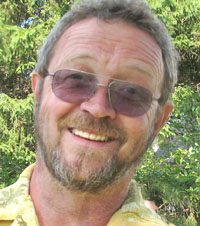Bear with me and I’ll share my tour of rare bare slab outlets in the Bay Area, and there abouts. Using a list I compiled from the internet and woodworking sites, I visited a few and on three occasions drove home with a slab or two in my truck.
The Berkeley East Bay area is bursting with slab sources, but I haven’t crossed that bridge yet. I’m starting with the outskirts, where the cost per board foot is often less.
Traverso Tree Service in Martinez doesn’t have a showroom, or a sales person, but they do have a huge backyard full of drying slabs from salvaged trees, and Jason the yardman is the cutter and stacker with a receipt book. He’ll estimate the cost on the fly and help you load your slabs into your truck. Much of their inventory consists of huge slabs. I came home with a tall, wide, straight slab of sequoia big enough to be a dining table for $100. It’s drying on a stand in my yard.
Miller’s Milling in Dixon is set up in a shopping mall along I-80. You can see the tall “Wood Slabs” sign as you drive by. Scot Miller rented a cavernous building, painted the walls white, and left the rest of the room unfinished. It’s piled high with slabs of redwood, claro walnut, and other species. Some lay flat. Many stand tall around the walls. He writes the price on many of his pieces so you can browse in silence and not have to calculate board feet in your head or call out, “How much is this one?”
Much of Scot’s inventory consists of slabs of more reasonable size for a hobbyist like me. Five to six feet tall is ideal, and he had plenty in that range. After an hour of anecdotes and valuable advice for me the greenhorn, I came home with three slabs of claro walnut, which only grows in California and Oregon. Two are on the drying rack in the back, and the dry one has already been transformed from nature to art.
Table sidebar: The finished table is shaped like a flame and has a challenging knot hole in the middle of its twisted dark center. After staring at the slab for days seeking inspiration, listening to music with it, sharing a beer, going with the grain, having friends say about the knothole, “It looks like Chewbacca,” the vision came to me. Red. The knothole could be the twisted mouth of a furry “Star Wars” hero, or it could be charred embers in a smoldering slab.
I went to Michaels. I bought everything they had in red, beads, stones, sequins, glitter, tinsel dust. I smashed up a pink hummingbird feeder in a cloth bag with a sledgehammer. Amazon sent me a bag of beautiful crushed red glass from New Hampshire. I filled the knothole, cracks, and crevices with various reds and poured on the epoxy in multiple layers. The glassy brown, black, and red surface glistens and glimmers as your angle to it changes. I call it Firewood and dedicate it in memory of the many recent California fires.
Heritage Salvage in Petaluma has more than an assortment of slabs of all shapes, sizes, and exotic species. They rescue all wood. When a building goes down, or a wood floor comes up, or a water tower topples over, Heritage is there to salvage the huge beams, bundles of finished lumber, and any other handsome wood headed for the sawdust heap.
If you like wood working and you have a vivid imagination, this place is a playground of potential. I went twice, spent a good hour talking with staff, Karen and Ross, and came home with some unique wood that has brought me great challenge and joy. It was a near nine-foot slab of eucalyptus robusta, aka swamp mahogany. The grain flowed nicely. I imagined it cut into four end tables.
Table sidebar: The finished tables look magnificent so far. Two are done. This robusta mahogany has a rich, amber-burgundy, tight-grained glow under the cured epoxy. It is also the hardest wood I’ve ever worked with.
I could not sand out the mill marks. I leaned into it with 50 grit on an orbital sander a good long time and got a thimble of dust. I tried 50 grit on a belt sander. “Ha, ha!” said the swamp wood. “I’m too slick for you. I’m a eucalyptus.” My sandpaper was sliding.
A hand planer did the trick set at 1/64th for 50 passes. “OK. You got me this time,” said the swamp wood. “Wait until you apply epoxy.” The battle was fierce, the learning curve steep, but I poured a beautiful plateau.
“And now come the legs,” the swamp mahogany snickered. The finished four tables required 80 screws total for the hairpin legs. Even with pilot holes, then pilot screws, I broke nine decorative screws and had to grind out the nubs. It was all worth it.
I could have visited more places, but I have a year’s supply of hobby wood stockpiled. What if I found one I liked? Man overboard.
Steve Gibbs is a retired Benicia High School teacher who has written a column for The Herald since 1985.







Leave a Reply